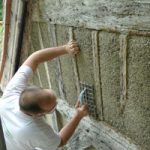Hemp-lime is a natural material consisting of hemp mixed in with mortar to produce light weight insulating mortars. It has a density of between 110 and 150 kg. per m3. The strands are between 5 and 25mm long. Originally developed in France to repair historic properties to replace deteriorating wattle and daub (a Lime, mud, horse hair and straw mix used as infill between timbers in traditional timber frame construction) with a more modern, insulatiing material, it is now being widely used to preserve other historic buildings throughout Europe.
Hemp-lime is found to be a low energy cost building material, requiring less cost to make and is easy to transport compared to other current building materials.
It was found that hemp-lime was flexible and robust with little shrinkage, ideal properties for use as an infill between large timbers which move and flex with the seasons and over time due to the actions of water and heat on the structure of the timber. Water when absorbed by the timber material causes the timber material to expand and swell while heat causes the timber to shrink and lose the stored water. Being a natural material, Hempcrete does not break in these conditions i.e. it can accommodate a certain amount of movement in the timber frame and which is highly compatible with the moisture behaviour of the timber itself and it works in harmony with the ancient timber frames with its ability to absorb and emit water vapour, protecting the timbers from damp.
Hemp lime can also provide insulation which can seal the gaps between timber frames. It also has an inherent thermal mass and can therefore help to control the internal temperature fluctuations which can be a problem in lightweight construction (typically 100 mm or so), or it can be cast to a greater thickness if the opportunity arises.
Fig.1: hemp-lime being applied to a wall
